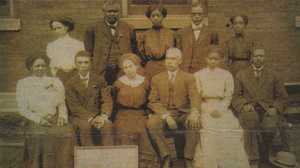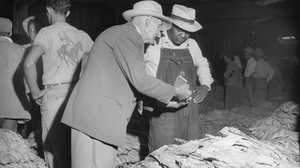Footprints Through Time
The medical discoveries of Alfred Blalock and Vivien Thomas had an enormous impact on the field of heart surgery. Their achievements went far beyond the stunning success of the blue baby operation, which saved the lives of countless children.
In the years following the perfection of that surgery, Blalock and Thomas trained a generation of surgeons, many of whom are still operating today. Both men were known as gifted, patient teachers, and their life-saving legacy remains the crowning achievement of their 34-year partnership.
Read profiles of Blalock, Thomas, Helen Taussig, and the medical professionals who followed in their footsteps.

Alfred Blalock (1899-1964)
Alfred Blalock was born in Culloden, Georgia in 1899 to a prominent business family. After graduating from the University of Georgia, he studied medicine at Johns Hopkins University, where he finished his residency. From 1925 to 1941, Blalock worked as resident surgeon at Vanderbilt University's medical school, his second choice after Hopkins. There, he and Vivien Thomas conducted research that ultimately showed that surgical shock was caused by loss of blood volume. While working at Vanderbilt, Blalock contracted tuberculosis; he recovered after treatment and was even more committed to research.
As a result of his Vanderbilt research on the physiology of shock, Blalock urged wider use of plasma or whole-blood transfusions to improve treatment for surgical shock. That finding saved millions of lives in World War II alone.
In 1941, Blalock joined the surgery staff of Johns Hopkins University, in Baltimore. He brought Thomas with him to collaborate on technical developments and supervise the experimental lab. At Hopkins, Blalock met Dr. Helen Taussig, head of the children's heart clinic at Hopkins. Taussig was concerned for children who suffered from the heart defect Tetralogy of Fallot, and speculated that the defect was caused by an obstruction of passages from the heart to the pulmonary arteries. Blalock accepted her challenge to develop a surgical procedure to relieve that obstruction. First, with Thomas, he demonstrated that Taussig's hypothesis was correct in laboratory animals. Then he and Thomas worked with Taussig to develop the procedure, known as the Blalock-Taussig shunt, that would alleviate the obstruction.
In 1944 Blalock, with Thomas advising over his shoulder, performed the first "blue baby" operation on 15-month-old Eileen Saxon. The operation was a success, although Saxon later died. In the following months and years, Blalock performed the procedure on thousands of children, often accompanied by Vivien Thomas. The operation not only directly saved thousands of lives, it marked the start of the modern era of cardiac surgery.
Blalock continued research on vascular surgery. With Edwards Park, he developed a bypass operation for coarctation of the aorta in 1944; and with Rollins Hanlon, he created a technique for overcoming another congenital defect, the transposition of the great blood vessels of the heart, in 1948. In teaching and in research he paved the way for a new generation of surgeons.
Blalock received numerous awards and honorary degrees. He died in 1964, leaving his wife, three children, and a legacy of healing and medical breakthroughs.
Vivien T. Thomas (1910 - 1985)
Vivien T. Thomas was born in New Iberia, Louisiana in 1910, the son of a carpenter. His family moved to Nashville, where Vivien graduated with honors from Pearl High School. Later in 1929 he was preparing for college and medical school when his savings for tuition disappeared following the October stock market crash. With no means for education, he took a job as a laboratory technician at Vanderbilt University's medical school, working for Dr. Alfred Blalock.
Thomas still hoped to save tuition money to earn his own medical degree, but the Great Depression worsened and the research with Blalock grew. Soon Thomas was working sixteen hours a day in the laboratory, performing operations on animals that would advance Blalock's studies of high blood pressure and traumatic shock. For his work, Thomas invented a heavy spring device that could apply varying levels of pressure. Blalock and Thomas' work at Vanderbilt created a new understanding of shock, showing that shock was linked to a loss of fluid and blood volume.
When Blalock became chief surgeon at Johns Hopkins University's medical school in 1941, he insisted that Vivien Thomas be hired to join his team there. At Johns Hopkins, Thomas and Blalock pioneered the field of heart surgery with a procedure to alleviate a congenital heart defect, the Tetralogy of Fallot ("blue baby syndrome"). Sufferers faced brutally short life expectancies. Working with cardiologist helen Taussig, Blalock and Thomas developed an operation that would deliver more oxygen to the blood and relieve the constriction caused by the heart defect. Thomas tested the procedure — a refinement of one that they had created in laboratory dogs -- on animals to make sure it would work. In 1944, with Thomas advising Blalock, the first "blue baby" operation was successfully performed on 15-month-old Eileen Saxon.
Thomas was a key partner in hundreds of "blue baby" operations, performing pre- and post-operation procedures on patients as well as advising in the operating room. At the same time, he continued to manage Blalock's ongoing laboratory research.
As head of the Hopkins surgical research laboratory, Thomas also taught a generation of surgeons and lab technicians. The residents and research fellows who worked with Thomas testified to his unique abilities and his dedication.
Helen Taussig (1898 - 1986)
Helen Taussig was born in Cambridge, Massachusetts in 1898, the youngest of four children. Her father was a prominent Harvard economist and her mother was a natural scientist who died of tuberculosis when Taussig was eleven years old. A childhood bout of whopping cough left Taussig with a significant loss of hearing.
Taussig completed her B.A. at the University of California at Berkeley in 1921. In pursuing a medical career, Taussig encountered daunting obstacles and discrimination. She enrolled in Harvard's School of Public Health, but women could not get a degree there. Taussig needed special permission to take courses at Harvard's medical school, which did not admit women until 1945. Her anatomy professor at Boston University suggested that she focus on the heart, and apply to medical school at Johns Hopkins.
Taussig received her M.D. from Johns Hopkins in 1927. She worked in the Hopkins pediatric cardiac clinic with Dr. Edwards Park, and in 1930 Taussig became physician-in-charge of the Hopkins children's pediatric clinic. In 1946 she became an associate professor of pediatrics.
Partly due to her hearing difficulty, which prevented her from using a stethoscope, Taussig mastered new technologies for diagnosis. She made expert use of x-rays, electrocardiographs, and innovative physical examination methods.
In 1942, Taussig concluded that the bluish appearance of cyanotic children resulted from a lack of oxygen in the blood. In "blue babies," she found that the lack of oxygen resulted from a blockage in the blood vessels to the lungs or a leak in the septum that divides the two halves of the heart. Taussig persuaded Dr. Alfred Blalock, a vascular surgeon, to try and relieve the obstruction. With Vivien Thomas, Blalock proved Taussig's hypothesis, then worked with her to develop a procedure, known as the Blalock-Taussig shunt, to alleviate the obstruction. The procedure, introduced in 1944, saved thousands of lives.
J. Alex Haller, Jr. (1927 - )
J. Alex Haller, Jr. was born in Pulaski, a town in southwestern Virginia, in 1927. After receiving his B.A. from Vanderbilt University in 1947, he studied at Johns Hopkins University School of Medicine and received his M.D. in 1951.
After his surgical residency at Hopkins, Haller moved to Kentucky and worked on the faculty of the University of Louisville, where he was named outstanding clinical professor in 1961, and as a pediatric surgeon at Louisville Children's Hospital.
In 1963 Haller returned to Johns Hopkins and joined the medical faculty in pediatrics, pediatric surgery and emergency medicine. He was Children's surgeon-in-charge from 1964 until 1997. Throughout, he pursued an interest in surgical problems of children, with a focus on congenital deformities of the chest wall, as well as on pediatric cardio-thoracic surgery and care for children with serious injuries. He wrote several books, including The Hospitalized Child and His Family (1967).
Haller established the regional trauma center for children at Johns Hopkins, the first of its kind in the United States. He also launched a training program for pediatric surgeons.
Raymond Lee (1941 - )
Raymond Lee was born in Baltimore, Maryland in 1941. At the age of three he moved to live with his grandmother in rural Virginia. By the time he was nine years old, he was accompanying her on her midwife rounds in the countryside, delivering babies 30 miles form the nearest hospital. Her example inspired him later in his career.
"I've been fortunate to meet people along the way who saw I had something to offer," Lee has said. He moved back to Baltimore to complete high school.
In 1959 he started working at Johns Hopkins University Hospital, first in housekeeping and then as an elevator operator. "I ran the Halsted elevator from the basement to the seventh floor, but God saw I should be going higher," he said, referring to the path his career took after meeting Vivien Thomas. Lee met Thomas on the elevator one day. When Thomas asked if Lee would be interested in working in the surgical laboratory, Lee jumped at the opportunity.
Working in the laboratory, Lee attracted the notice of Dr. Alex Haller, who saw that Lee had the skills to be a physician's assistant. Lee was the first physician's assistant in the cardiac service at Hopkins, and worked in that capacity until 1994. His career and dedication have been noted in the Baltimore Sun and elsewhere.
Denton A. Cooley (1920 - )
Denton A. Cooley grew up in Houston, Texas and studied at the University of Texas at Austin before pursuing his M.D. at Johns Hopkins University. Cooley continued at Hopkins as intern and resident, and assisted Dr. Alfred Blalock in the first blue-baby operation in November 1944, which corrected a deadly heart defect. That experience inspired Cooley; he chose to specialize in heart surgery.
In 1954, Colley returned to Houston and joined the faculty of Baylor University's medical school, already famous for the work of heart surgeon Dr. Michael DeBakey. Cooley worked with DeBakey on techniques for removing aortic aneurysms. Cooley's reputation grew through his work on repairing damaged heart valves with artificial replacements, and his establishment of the Texas Heart Institute in 1962. His relationship with DeBakey became more of a rivalry.
Soon after Dr. Christaan Barnard performed the first successful heart transplant in South Africa in December 1967, Cooley learned from that technique and repeated the operation in May 1968, implanting the heart of a 15-year-old girl into the body of a 47-year-old patient. The patient recovered but died seven months later. Cooley refined the operation in the following months. At one point he was conducting as many as 22 heart transplants a year.
In 1969 Cooley implanted the first complete artificial heart, which sustained the patient until a permanent donor heart was available. The operation was controversial and DeBakey, who accused Cooley of improper conduct, moved to have Cooley censured. Cooley resigned from Baylor and devoted all his time to his Texas Heart Institute.
He began doing coronary bypasses in the 1970s, and throughout his career promoted education for heart disease prevention. Cooley and his associates have together performed over 98,000 open heart operations. He has received the National Medal of Freedom and the Rene Leriche Prize, the highest honor of the International Surgical Society.
Rowena Spencer (1922 - )
Rowena Spencer, one of the first women to become a pediatric surgeon in the United States and the first woman surgical intern at Johns Hopkins, was born July 3, 1922 in Louisiana. After receiving her bachelor's degree, she entered Johns Hopkins Medical School in December 1943.
Because Johns Hopkins had admitted women to its medical school since 1900, Spencer faced little prejudice initially. However, she was forced to leave the examining room when males were examined for hernias. Later, when she was barred from having male urology patients, she successfully protested. Spencer received her medical degree from Johns Hopkins in 1947.
Spencer applied to Dr. Alfred Blalock for a surgical internship at the Hopkins hospital. When she first mentioned her intention to him, Blalock tried to discourage her. Ultimately, though, he yielded and Spencer became the first woman intern in general surgery there. She learned pediatric surgical technique from Vivien Thomas, Blalock's laboratory technician. Throughout her career, when complimented on her surgical technique, she always pointed out that she learned her skills from Mr. Thomas.
Despite strong recommendations from Blalock, Spencer was denied further training at Hopkins. She took a residency in pediatric surgery at the Children's Hospital of Philadelphia, under Dr. C. Everett Koop, who later became the U..S. surgeon-general. In her pursuit of surgical training, Spencer repeatedly encountered administrators who refused to accept women surgeons.
Spencer worked at surgical fellowships at Tulane University and several years at Louisiana State University, before performing a year of pediatric surgery in Stockholm, Sweden.
She became the first woman appointed to the full-time surgical staff at Louisiana State University and the first female surgeon in the state of Louisiana. Spencer practiced pediatric surgery at Tulane University Hospital from 1968 until 1977, and then worked in private practice until her retirement in 1984. Throughout her career, she faced resistance from residents who did not want to take instruction from a woman, and colleagues who disparaged her work.
After retiring, Spencer began research on the subject of conjoined twins, and became one of the world's leading authorities on the topic. She published a number of important papers on the embryology of conjoined twins.
Levi Watkins, Jr. (1945 - )
Levi Watkins, Jr. was born in Parsons, Kansas, the third of six children. His father was a college professor who moved the family to Alabama for a job with Alabama State University. The minister of the family's church in Montgomery was Dr. Ralph Abernathy, the civil rights leader. In high school, Watkins joined the Dexter Avenue Baptist Church, led by Dr. Martin Luther King Jr. At Dr. King's request, Watkins drove the church station wagon on Sunday mornings. He played an active role in the Montgomery bus boycotts of the 1950s.
Watkins attended Tennessee State University and, inspired by what he'd seen at Dr. King's side, "felt it was time Vanderbilt was integrated." In May 1966 he became the first African American ever admitted to Vanderbilt University's medical school. He learned that he was accepted from a headline in the Nashville Tennessean.
In 1970, Watkins began a surgical internship at Johns Hopkins University Medical School. During the period 1973 to 1975, he interrupted his surgical training to conduct cardiac research at Harvard Medical School. His research on the role of the renin angiotensin system in congestive heart failure was a breakthrough, and led to the use of angiotensin blockers in treating heart failure.
After returning to Hopkins, he became the university's first black chief resident in cardiac surgery. In 1978 Watkins joined the faculty as an associate professor. In 1979 he joined the medical school's admissions committee, intent on broadening the participation of minorities. In just four years, minority representation quadrupled among students, and had grown similarly among the faculty's ranks. In 1983, he was appointed to the national board of the Robert Wood Johnson Minority Faculty Development Program, which aims to increase the number of minority faculty members across the country.
Soon after joining the surgical team at Johns Hopkins Hospital, Watkins performed an operation that attracted the notice of the international medical community. In February 1980, he became the first surgeon to implant an automatic implantable defibrillator into a human heart. This treatment has since saved the lives of over 100,000 people.
In 1991, Watkins was promoted to full professor of cardiac surgery, and within months was appointed dean for postdoctoral programs and faculty development for the medical school. In that capacity he has transformed postdoctoral education in America. His life has been featured in magazines and national television programs.
Koco Eaton (1961 - )
Koco Eaton was born in 1961. After graduating from Columbia University in 1983, he attended Johns Hopkins School of Medicine, graduating there in 1987.
Dr. Eaton completed a fellowship at the American Sports Medicine Institute, and served as an orthopedic consultant to the Birmingham Barons, a Class AA baseball team affiliated with the Chicago White Sox. He worked with the Baltimore Orioles during spring training from 1990 to 1992, and later became orthopedic team physician for the Tampa Bay Devil Rays. There he works with Dr. James Andrews, medical director and head of the Sports Medicine Committee of the U.S. Olympic Committee.
Dr. Eaton also operates a private practice in sports medicine and orthopedic surgery in St. Petersburg, Florida.







